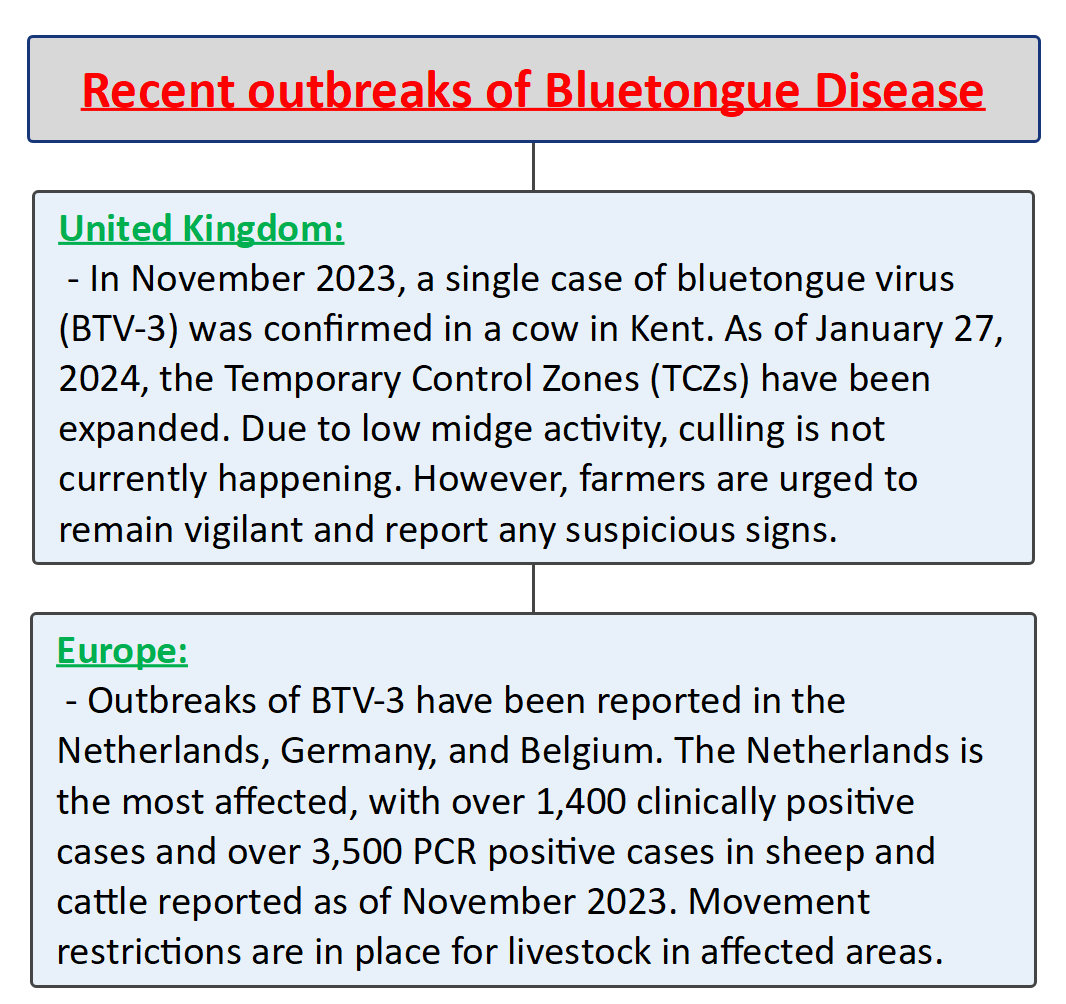Description

Copyright infringement not intended
Picture Courtesy: https://www.youtube.com/watch?v=PctyUk9LmfE&ab_channel=Dr.RiteshVerma-Vet.Mate
Context: China has implemented import bans on ruminants and their related products from Iraq, Belgium, and the Netherlands due to outbreaks of bluetongue disease in these countries.
About Bluetongue Disease
- Bluetongue disease is a viral illness that primarily affects ruminants, including sheep, cattle, goats, and deer. It is caused by the bluetongue virus (BTV), which belongs to the genus Orbivirus within the family Reoviridae.
- Bluetongue disease is transmitted by certain species of biting midges (Culicoides spp.), which serve as vectors for the virus. These insects can become infected after feeding on the blood of an infected animal and then transmit the virus to other susceptible animals during subsequent feedings.
Transmission and Spread
- Bluetongue virus is primarily transmitted through the bites of infected Culicoides midges.
- The virus does not spread directly from animal to animal or through contact with infected tissues or body fluids.
- The disease is more prevalent in warm and temperate regions where Culicoides midges thrive, although outbreaks can occur in cooler climates during warmer months.
.jpg)
Clinical Signs
- The severity of bluetongue disease can vary depending on the strain of the virus and the species of animal affected.
- Clinical signs may include fever, excessive salivation, nasal discharge, swelling of the face and tongue (giving it a bluish appearance), lameness, respiratory distress, and in severe cases, death.
- Infected animals may also exhibit signs of depression, lethargy, and reduced appetite.
Diagnostic Methods
- Bluetongue disease can be diagnosed through various laboratory tests, including virus isolation, serological assays (such as enzyme-linked immunosorbent assay or ELISA), and polymerase chain reaction (PCR) testing.
- Clinical signs and post-mortem examinations can also provide valuable diagnostic information.
Impact on Livestock
- Bluetongue disease can have significant economic consequences for livestock producers due to decreased productivity, trade restrictions, and control measures.
- Affected animals may experience reduced weight gain, decreased milk production, and reproductive problems.
- In severe cases, outbreaks can lead to substantial mortality rates, particularly in naive populations with no previous exposure to the virus.

Control and Prevention
- Control measures for bluetongue disease focus on vector control, vaccination, and movement restrictions.
- Vector control strategies include the use of insecticides, environmental management to reduce breeding sites for Culicoides midges, and implementing measures to minimize animal exposure to vectors.
- Vaccination is available for certain strains of bluetongue virus and is often used in endemic regions or areas at risk of outbreaks.
- International trade regulations may include import restrictions on animals and animal products from regions affected by bluetongue disease to prevent the spread of the virus to unaffected areas.
Global Distribution
- Bluetongue disease is endemic in many regions of the world, including Africa, the Middle East, Asia, Australia, and parts of Europe and the Americas.
- The distribution of the disease is influenced by factors such as climate, vector abundance, livestock management practices, and trade patterns.

|
PRACTICE QUESTION
Q. What is the primary vector responsible for transmitting the Bluetongue virus?
A) Mosquitoes
B) Ticks
C) Biting Midges
D) Fleas
Answer: C
Explanation:
Bluetongue virus (BTV) is primarily transmitted by biting midges, specifically those belonging to the genus Culicoides. These small insects, commonly known as Culicoides midges or sandflies, play a crucial role in the transmission cycle of the virus. When infected midges feed on the blood of a viremic (infected) host, they can acquire the virus. Subsequently, these infected midges can transmit the virus to susceptible animals during their subsequent blood meals.
The virus does not spread directly from one infected animal to another or through contact with contaminated materials. Instead, Culicoides midges act as biological vectors, contributing to the spread of the Bluetongue virus among ruminant populations. Vector control measures, such as insecticide use and environmental management to reduce breeding sites for Culicoides, are often important components of strategies to control and prevent the disease.
|












